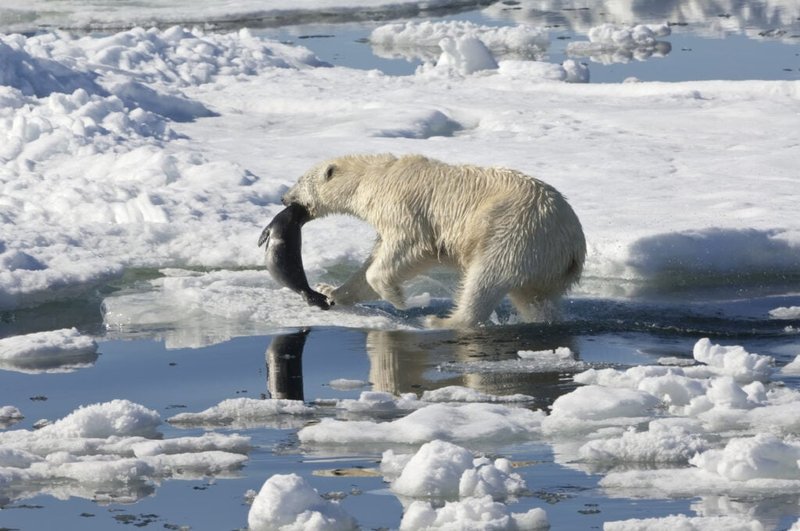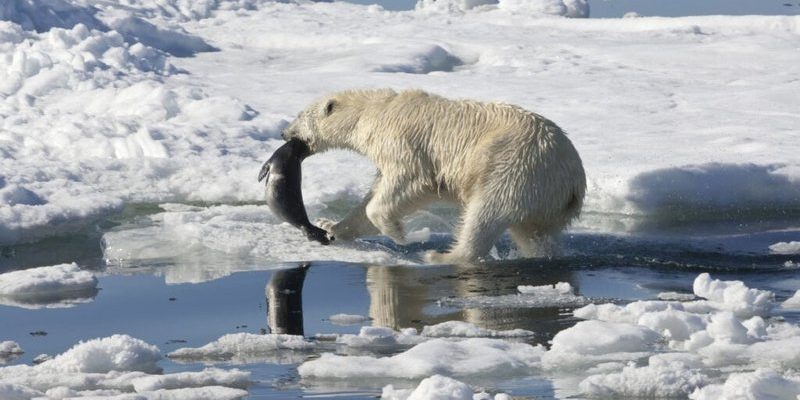
Polar bears are not just adorable fluffballs; they’re the ultimate hunters of the ice. Their diet is specialized, heavily relying on the unique environment they inhabit. You might wonder how these incredible animals manage to thrive in one of the harshest climates on Earth. Let’s dive in and explore what polar bears eat and how they use their instincts and skills to hunt in their frozen playground.
What Do Polar Bears Eat?
Let’s start with the basics: the polar bear’s diet primarily consists of seals. But not just any seals — they prefer ringed seals and bearded seals. These seals are abundant in the Arctic and are rich in fat, which is crucial for the polar bear’s survival, especially during the long winter months when food can be scarce. Think of seals as the polar bear’s version of a greasy cheeseburger — packed with energy!
Polar bears can consume around 100 pounds of seal blubber in one sitting. This high-fat diet is essential because it helps them build up a layer of blubber that keeps them warm in freezing temperatures. The fat also supplies the energy needed for their often-arduous hunting trips. During a good feeding spree, a polar bear can eat over 60 seals in a single year. That’s some serious dining!
While seals are their primary food source, polar bears aren’t picky eaters. They may also munch on carcasses of whales or walruses when they come across them. In leaner times when seal hunting is tough, they might nibble on seaweed or berries. But let’s be clear: seals are their top choice!
Hunting Techniques of Polar Bears
Now, let’s talk about how these bears do their hunting. Polar bears are impressive, stealthy hunters, and they have several tricks up their sleeves. One of the most fascinating techniques is called still-hunting. Here’s how it works: a polar bear will position itself near a breathing hole in the ice, which is where seals pop up for air.
As the bear waits silently, it uses its strong sense of smell to detect when a seal is nearby. Patience is key here! The bear can remain still for hours, camouflaged against the white ice and snow, almost like a ninja in a snowy battlefield. When the moment is right, they’ll strike with incredible speed and power, catching the unsuspecting seal off guard. Isn’t that a thrilling tactic?
Another hunting strategy is walking on the sea ice to find seal dens. These dens are usually made in the snow drifts where mother seals give birth to their pups. Polar bears will sniff around, looking for signs of life. Once they locate a den, they’ll dig through the snow to access the seals inside. It’s like finding a hidden treasure chest filled with delicious food!
Seasonal Changes in Diet
The diet of polar bears isn’t static; it changes with the seasons. During spring and summer, when sea ice begins to melt, polar bears have more opportunities to hunt seals. They become incredibly efficient, using their skills to capitalize on the abundance of seals swimming in open water.
However, as autumn approaches and winter sets in, the hunting becomes more challenging. Sea ice starts to freeze over, and seals are less accessible. During these times, polar bears may enter into a state called walking hibernation. Even though they’re not technically hibernating, they become less active and conserve energy.
You might be wondering how bears cope with these seasonal changes. Well, they rely on their thick layer of blubber for sustenance during lean times. As the ice returns, they become more active and resume hunting, regaining the weight they lost. It’s a smart way to adapt to an ever-changing environment!
Impact of Climate Change on Food Sources
Unfortunately, the Arctic environment is changing due to climate change, which poses a serious threat to polar bears and their food sources. As the planet warms, sea ice is melting at alarming rates, disrupting the natural balance of this ecosystem. It’s like taking away a restaurant where polar bears used to feast!
With less ice, seals have fewer places to rest and breed, which directly affects the polar bears’ ability to catch them. Research has shown that polar bear populations are struggling to find enough food during the warm months, leading to malnutrition and lower survival rates.
The future looks uncertain, and it’s a heavy topic. But there’s still hope! Conservation efforts and climate change awareness continue to grow, aiming to protect polar bears and their icy home. It’s a global effort that highlights the importance of preserving this unique ecosystem for future generations.
Unique Adaptations for Hunting
Polar bears have evolved specific adaptations that make them formidable hunters in the Arctic. Their keen sense of smell is one of their most critical tools. Polar bears can smell a seal nearly a mile away, even if it’s buried under several feet of snow. That’s like us detecting a fresh pizza from blocks away!
Another cool adaptation is their large paws, which help them walk on thin ice and distribute their weight effectively. These paws act like snowshoes, preventing them from falling through the icy surface. They also have sharp claws that make them excellent climbers and diggers, allowing them to break through thick ice layers and reach their prey.
Additionally, the polar bear’s fur isn’t just for looks. Each hair is actually translucent and reflects light, helping them blend into their icy surroundings. This camouflage is crucial for sneaking up on seals without being noticed. It’s like wearing a perfect disguise during a game of hide-and-seek!
The Role of Polar Bears in the Ecosystem
Polar bears are not just apex predators; they play a vital role in their ecosystem. As they hunt seals, they help control the seal population and maintain a healthy balance in the Arctic food web. This is important because too many seals could lead to overgrazing of the underwater vegetation, impacting other species and the entire ecosystem.
Moreover, when polar bears scavenge and leave behind leftover carcasses, they provide nutrients for other wildlife, including scavengers like Arctic foxes and birds. This interconnectedness shows just how crucial polar bears are to the health of the Arctic environment.
So, the next time you see a picture of a polar bear lounging on an ice floe, remember that it’s not just a cute face — it’s an essential player in the complex game of life in the Arctic!
The diet and hunting strategies of polar bears paint a vivid picture of survival in one of Earth’s most challenging habitats. From their specialized diets focused on rich, fatty seals to their unique hunting techniques and adaptations, these magnificent animals exemplify the delicate balance of life in the Arctic.
However, as we face the challenges of climate change, it’s crucial to understand and support efforts to protect these iconic creatures and their environment. After all, the survival of polar bears isn’t just about them; it’s about preserving a rich ecosystem that impacts our planet as a whole. So, the next time you think of polar bears, remember their story, and consider how we can help keep their icy world alive and thriving.

